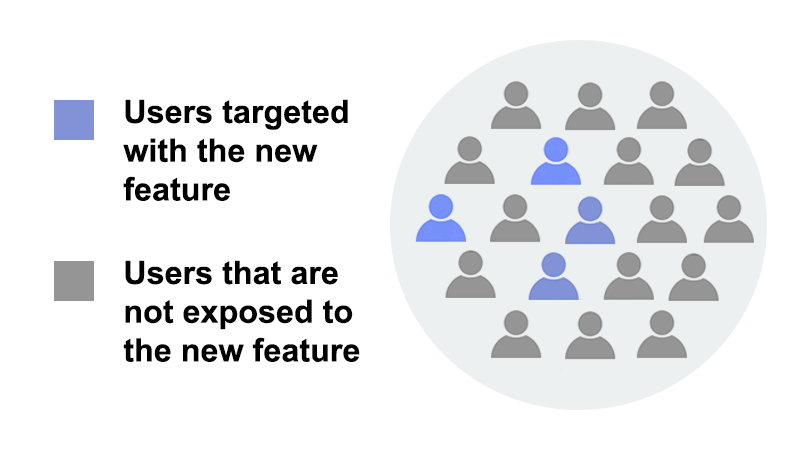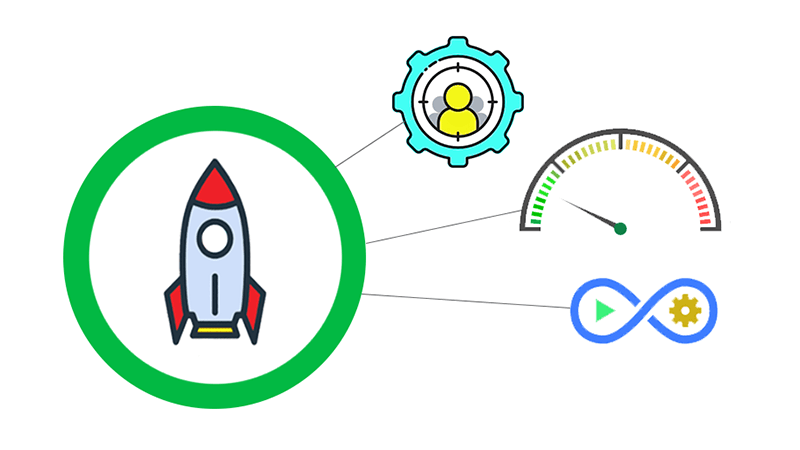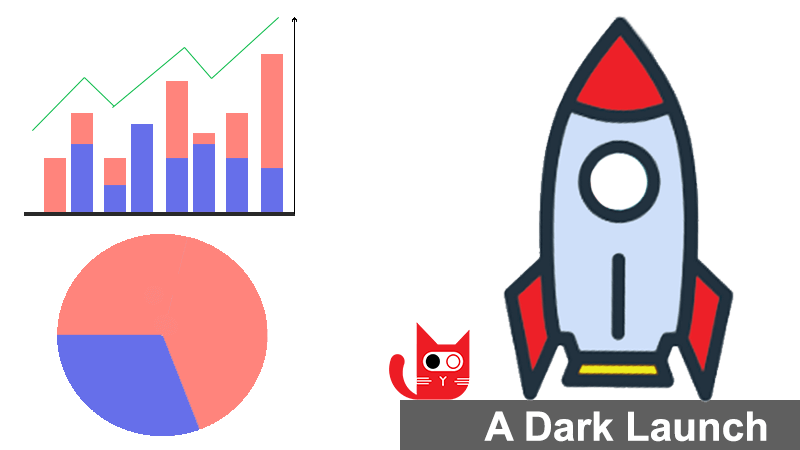The Benefits of Dark Launches in Software Development
In the ever-evolving landscape of software development, delivering high-quality software that meets user expectations is a formidable challenge. The journey from conceptualizing innovative features to their seamless integration into a live application involves careful consideration, testing, and risk management. One valuable tool that has emerged to address these challenges is the concept of dark launches. This strategic deployment technique allows development teams to introduce and test new software features with precision, unlocking controlled innovation and user-driven improvements. Let's further explore the concept of dark launches and what they offer to development teams.

What are Dark Launches?
Dark launches are a strategic deployment technique that allows developers to selectively introduce new software features or changes to a specific subset of users while keeping them hidden from the majority. This approach mitigates risks and protects the broader user base from potential issues. Dark launches work through feature toggles that wrap around new software features, enabling controlled exposure to users.

Imagine unveiling new features to a select few, gathering real-world feedback, and perfecting your product, all while the majority of users remain blissfully unaware.
The Evolution of Dark Launches
Dark launches have evolved in response to challenges encountered in early software development. Traditional monolithic releases posed difficulties in testing and risk management. With the introduction of Feature Flags, dynamic feature activation without redeployment became possible. Dark launches emerged as a solution to these issues, enabling controlled, incremental, and less disruptive feature deployment while emphasizing risk mitigation, user feedback, and continuous improvement.
Over the years, dark launches have continued adapting to the changing landscape of software development, embracing a user-centric approach, enabling A/B testing and experimentation, streamlining feature management, and allowing for personalized user experiences through conditional rollouts. This evolution has made dark launches an integral part of modern software development practices.
Demystifying Dark Launches, Canary Releases, and Feature Flags
Dark launches, canary releases, and feature flags are essential concepts in modern software development. Let's see how they differ from one another:
Dark Launches vs. Canary Releases
Dark launches emphasize controlled and incremental feature deployment by selectively enabling new features for specific users or groups while keeping them hidden from the majority of users. The primary aim is to collect feedback and mitigate risks. In contrast, canary releases focus on a gradual rollout, typically releasing a new software version to a limited subset of users first. These early users act as 'canaries in a coal mine,' aiding in early issue detection during deployment. Canary releases prioritize ensuring the stability and performance of the software version before a wider audience gains access. In essence, dark launches prioritize feedback and risk mitigation, whereas canary releases prioritize stability testing.
Dark Launches vs. Feature Flags
Dark launches represent a specific application of feature flags, with a focus on controlled and incremental feature deployment. Feature flags, in a broader sense, encompass the practice of selectively enabling or disabling features within software. They offer flexibility in managing feature visibility and functionality.
Feature Flags facilitate dark launches to conceal and then gradually reveal new features for controlled deployment. Feature flags can serve various purposes, extending beyond dark launches. They are versatile tools that can also be used for experimentation, personalized user experiences, and dynamic feature toggling without necessitating code changes.
The key distinction lies in the fact that dark launches are a subset of feature flags designed explicitly for controlled feature rollout, with a strong emphasis on risk mitigation and user feedback.
Advantages of Dark Launches

Dark launches offer several benefits:
-
Reduced Risk: Dark launches allow for a gradual feature rollout, which in turn enables early issue detection. By introducing new features to a limited audience first, any potential problems can be identified and addressed before they impact the entire user base. This risk mitigation strategy not only safeguards the user experience but also minimizes the costs associated with fixing issues in a full-scale release.
-
Faster Time-to-Market: Dark launches provide developers with the flexibility to innovate and experiment without the pressure of an immediate, full-scale release. This agility fosters a culture of continuous improvement and innovation, as developers can deploy quickly to production with confidence, knowing that they can easily test and refine new features or rollback as needed.
-
Integration with CI/CD: Dark launches can seamlessly be integrated into Continuous Integration and Continuous Delivery (CI/CD) pipelines. It aligns with the practice of continuously delivering and testing code changes, which is fundamental to modern software development. This integration ensures a smoother development workflow, as feature flags can be managed and monitored in alignment with the CI/CD process, enabling efficient and controlled releases.
Dark Launch Pitfalls to Avoid
While dark launches offer numerous benefits, several common pitfalls should be avoided during implementation:
-
Overcomplication: Using too many feature flags or toggles can lead to complexity and confusion.
-
Forgetting to Remove Flags: It's essential to clean up feature flags and toggles once they've served their purpose.
-
Insufficient Testing: Dark launches should not replace thorough testing. It's crucial to rigorously test new features before a dark launch to catch major issues early.
-
Lack of Clear Metrics for Success: Without clear goals and metrics, it's challenging to measure the success of a dark launch. Define what success looks like for each feature release.
-
Inefficient Rollback Strategies: Always have a plan for a quick rollback in case of unexpected issues when implementing dark launches.
Dark Launch use cases
Dark launches have proven to be a versatile tool in the software development arsenal. Let's look at various use cases where dark launches offer substantial benefits:
-
A/B Testing: Dark launches are instrumental in A/B testing scenarios. By releasing two different versions of a feature to separate user groups, companies can effectively measure the impact of changes and optimize their product accordingly. This approach aids data-driven decision-making and ensures that only the most effective version is rolled out to the entire user base.
-
Feature Rollouts: Dark launches enable a gradual rollout of features, which is particularly useful for large-scale applications or platforms. Instead of launching a massive update at once, developers can release it incrementally, monitoring user feedback and system performance throughout the process.
-
Hotfix Deployments: In cases of critical bug fixes or security updates, dark launches allow for quick hotfix deployments. These changes can be introduced discreetly, ensuring minimal disruption to users while still addressing critical issues.
-
Traffic Management: Dark launches are effective at managing traffic during high-demand periods. For example, dark launches are employed by e-commerce websites to quietly introduce and test new functionalities during peak shopping seasons or promotional events, ensuring a seamless user experience.
-
User Personalization: Companies aiming to enhance user personalization can employ dark launches to test new algorithms or recommendation engines on a smaller audience. This approach helps fine-tune the algorithms before implementing them for the entire user base, thereby improving customer satisfaction.
A short Dark Launch implementation guide
Here's a step-by-step guide to help integrate dark launches into your development process using ConfigCat as your feature flag management provider:
- Clearly outline what you aim to achieve with dark launches. Determine the specific features or changes you want to test and the desired outcomes.
- Visit the ConfigCat website and sign up for an account.
- Depending on your programming language or framework, install the appropriate ConfigCat SDK. This SDK will enable you to use feature flags in your code.
- Within ConfigCat, create feature flags that correspond to the features or changes you want to test. Customize their conditions for controlled rollout. You can learn more about this here.
- Integrate the ConfigCat SDK into your application code. Use the feature flags you created to wrap the new features, enabling controlled exposure. Feel free to consult the open-source sample apps on how to integrate ConfigCat in various applications.
- Begin the dark launch by selectively exposing the new features to a limited audience or specific environments.
How to measure success and adjust the impact of a Dark Launch?

While the dark launch is running, make sure to:
- Measure the impact on user engagement with the new feature.
- Analyze the number of bug reports and issues raised during the dark launch phase.
- Assess how the feature affects conversion rates or other relevant KPIs.
- Gather user feedback to gauge their satisfaction and uncover any issues.
- Monitor the performance of your application or system during the dark launch phase.
Based on user feedback and data, make necessary adjustments to the feature. This iterative approach helps refine the changes before a broader release. As you gain confidence in the new features' stability and user acceptance, gradually expand their rollout to larger user groups.
Conclusion
Dark launches are crucial for risk mitigation, user experience improvement, and data-driven decision-making in software development. By adopting this approach, businesses not only elevate user satisfaction but also achieve an invaluable competitive edge. As such, integrating dark launches into development processes paves the way for groundbreaking innovation and heightened efficiency, ensuring that organizations stay ahead in a dynamic and competitive market.
ConfigCat supports simple feature toggles, user segmentation, and A/B testing and has a generous free tier for low-volume use cases or those just starting out.
For more insights on feature flags follow ConfigCat on Facebook, X (Twitter), LinkedIn, and GitHub.
